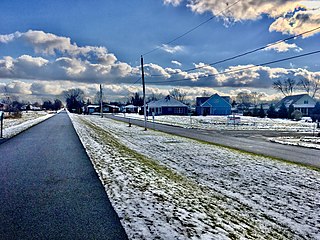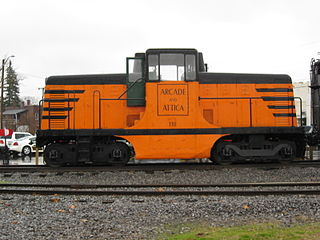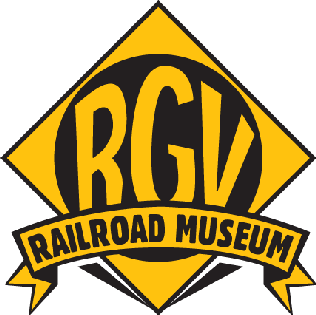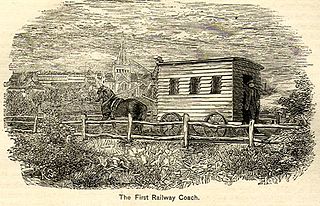This article's tone or style may not reflect the encyclopedic tone used on Wikipedia.(February 2013) |
The Tonawanda Railroad was a railroad company established in Rochester, New York in 1832. It was eventually absorbed by the New York Central.
This article's tone or style may not reflect the encyclopedic tone used on Wikipedia.(February 2013) |
The Tonawanda Railroad was a railroad company established in Rochester, New York in 1832. It was eventually absorbed by the New York Central.
Like other growing towns and cities, Batavia needed access to affordable and reliable commercial transportation services. The Erie Canal provided a solution for most of upstate New York, but it did not reach Batavia. Instead, canal designers selected Eighteen Mile Creek as the area to scale the formidable Niagara Escarpment. The Tonawanda's two wood-burning locomotives were delivered to the area by canal boat, five years after the company was chartered.
The Tonawanda Railroad was chartered on 24 April 1832 for the purpose of building a rail line from Rochester to Attica and eventually Buffalo. Initially, the route was to have included Scottsville, Mumford, Caledonia, and Le Roy before a more direct route to Batavia was adopted. These areas were later served by construction of the Scottsville & LeRoy Railroad.
This was the second railroad to be built in New York State, following the Mohawk and Hudson, the Albany-to-Schenectady road, which began 17 April 1827. This railroad was named after Tonawanda Creek, which flows through Batavia. Historian Edward Dunn questions the derivation of the naming, as the eleven miles of line constructed up the valley of the Tonawanda Creek to Attica was an afterthought. [1] This part was constructed in 1841, well after the company was founded and named.
Dunn noted that developers intended simply to build a connection with the Attica and Buffalo Railroad. With the completion in 1853 of the shorter and more direct Buffalo and Rochester Railroad, the Attica and Buffalo was sold to the Erie Railroad. [1]
The line reached South Byron by 1836, and service with horse cars began. The first primary section, 31½ miles from Rochester southwest to Batavia, opened 5 May 1837; the rest of the line followed the valley of the Tonawanda Creek to Attica by 1842, opening on 8 January 1843. The chief engineer for the project was Elisha Johnson.
In 1888, the Batavia newspaper wrote:
"The Tonawanda railroad was intended to run from Rochester to Buffalo, via of Batavia. In 1836 the road was completed to South Byron, about eight miles Northeast of Batavia, and cars were run as far as that point, horses furnishing the motive power. A year later the road reached Batavia which was then the terminus. The Company then purchased of James BRISBANE, a wealthy merchant and extensive land owner in the village, six acres of land on which to locate their depot. The road as originally mapped out was to run North of Main street in Batavia and the depot was to be located near the present site of Mr. George BRISBANE's residence. It was then the intention to cross the Tonawanda Creek where the Alleghany road bridge now is, and taking the line now followed by the new Buffalo road go direct to Buffalo, but through the influence of men owning the property on the South side of the street, the engineer was induced to change the route and locate it where their property would be more likely to appreciate in value. The Company built their first depot at the corner of Big Tree street (now Ellicott street) and South street, (now Jackson street) in the village of Batavia.
The first ticket agent of the Central road at Batavia was Erastus SEYMOUR, who kept a book and registered the name of every passenger who purchased a ticket. This book came into the possession of Mr. MIX several years ago and was later given to Ellis N. OSBORNE, then the Central's station agent at Batavia. After Mr. OSBORNE's death his son presented the book to the Buffalo Historical Society, which now has it among many interesting and valuable relics of the pioneer days of Western New York.
The first depot was built with the track running through the same and having large doors at each end in which the cars were locked up every night. A track was laid from the depot along Ellicott street to a point near the present site of the Court House, at which point was located the turn-table and water tank. The opening of the road from Rochester to Batavia was celebrated May 8th, 1837, with a grand demonstration, great crowds coming from the surrounding country to see the first locomotive. April 13th, 1840, the Legislature granted an extension of three years time for the completion of the road from Batavia to Attica, and May 1st of that year the State of New York loaned the Tonawanda railroad $100,000 with which to go on with the construction. At Attica the road connected with the Attica & Buffalo Railroad, which had been chartered by the Legislature May 13th, 1836. These roads were completed, and opening of a through line from Rochester to Buffalo via Batavia and Attica was celebrated January 5th, 1843. April 9th, 1850, the Tonawanda Railroad and the Attica and Buffalo Railroad were authorized to consolidate and change the name of the corporations to the Rochester and Buffalo Railroad, and also to shorten the distance between Rochester and Buffalo by the construction of a branch or second line running direct to Buffalo from Batavia. This is the line now occupied by the four tracks of the New York Central." [2]
Railroads went through frequent changes as more were brought into operation. On 7 December 1850, the Tonawanda Railroad and the Attica and Buffalo Railroad merged to form the Buffalo and Rochester Railroad. [3] That railroad was one of ten that merged on 17 May 1853 to form the New York Central Railroad.
This Tonawanda was not related to the similarly named Tonawanda Valley Railroad, the Tonawanda Valley Extension Railroad, or the Tonawanda Valley and Cuba Railroad, all three of which were merged into the new Tonawanda Valley and Cuba Railroad in 1881. It went bankrupt three years later, after having built sections of its route over unstable quicksand.[ citation needed ]

The Erie Canal is a historic canal in upstate New York that runs east–west between the Hudson River and Lake Erie. Completed in 1825, the canal was the first navigable waterway connecting the Atlantic Ocean to the Great Lakes, vastly reducing the costs of transporting people and goods across the Appalachians. In effect, the canal accelerated the settlement of the Great Lakes region, the westward expansion of the United States, and the economic ascendancy of New York State. It has been called "The Nation's First Superhighway."

Tonawanda is a city in Erie County, New York, United States. The population was 15,129 at the 2020 census. It is at the northern edge of Erie County, south across the Erie Canal from North Tonawanda, east of Grand Island, and north of Buffalo. It is part of the Buffalo-Niagara Falls metropolitan area.

Tonawanda is a town in Erie County, New York, United States. As of the 2020 census, the town had a population of 72,636. The town is at the north border of the county and is the northern inner ring suburb of Buffalo. It is sometimes referred to, along with its constituent village of Kenmore, as "Ken-Ton". The town was established in 1836, and up to 1903 it included what is now the city of Tonawanda.

The New York Central Railroad was a railroad primarily operating in the Great Lakes and Mid-Atlantic regions of the United States. The railroad primarily connected greater New York and Boston in the east with Chicago and St. Louis in the Midwest, along with the intermediate cities of Albany, Buffalo, Cleveland, Cincinnati, Detroit, Rochester and Syracuse. New York Central was headquartered in New York City's New York Central Building, adjacent to its largest station, Grand Central Terminal.

Tonawanda Creek is a small tributary of the Niagara River in Western New York, United States. After rising in Wyoming County, the stream flows through Genesee County before forming part of the boundary between Erie County and Niagara County.

The Arcade and Attica Railroad is a shortline railroad that hauls freight between Arcade and North Java, New York. The railroad originally connected Arcade with Attica; however, the right of way from North Java north to Attica was abandoned in 1957 due to flooding on the Tonawanda Creek.
The Buffalo and Rochester Railroad was a railroad company formed on December 7, 1850 by the merger of the Tonawanda Railroad and the Attica and Buffalo Railroad. The company remained in business for three years before it was merged with other companies into the New York Central Railroad.
The Auburn and Rochester Railroad was a railroad company based in New York state in the 19th century.
The Buffalo and Niagara Falls Railroad was a part of the New York Central Railroad system, connecting Buffalo, New York to Niagara Falls. It is still used by CSX for freight and Amtrak for passenger service.
The Genesee Valley Canal Railroad was a part of the Pennsylvania Railroad system in western New York. It was built on the former Genesee Valley Canal alignment.

New York State Route 33 (NY 33) is an east–west state highway in western New York in the United States. The route extends for just under 70 miles (113 km) from NY 5 in Buffalo in the west to NY 31 in Rochester in the east. It is, in fact, the only state highway that directly connects both cities, although it is rarely used today for that purpose. The westernmost 10 miles (16 km) of NY 33 in Buffalo and the neighboring town of Cheektowaga have been upgraded into the Kensington Expressway. This section of NY 33 is one of several freeways leading out of downtown and serves as a main route to the Buffalo Niagara International Airport.

New York State Route 354 (NY 354) is a state highway in New York in the United States. NY 354 is one of several highways radiating eastward from its western terminus in downtown Buffalo. The east terminus of NY 354 is in the village of Attica, where it ends at NY 98 and NY 238 as West Main Street. This highway runs through the center of Erie County to the northern county line of Wyoming County.

New York State Route 98 (NY 98) is a state highway in the western part of New York in the United States. The southern terminus of the route is at an intersection with U.S. Route 219 (US 219) in the town of Great Valley in Cattaraugus County. The northern end is at an interchange with the Lake Ontario State Parkway in the town of Carlton in Orleans County, near the southern shore of Lake Ontario. In between, NY 98 serves the city of Batavia, connects to the New York State Thruway, and passes by the Attica Correctional Facility. Most of the route passes through rural, undeveloped areas; however, in southern Genesee County, it traverses more urbanized areas that lie in and around Batavia.
The Rochester Subdivision is a railroad line owned by CSX Transportation in the U.S. state of New York. The line runs from Solvay, New York, west to Churchville, New York, along the former New York Central Railroad water level route. At its east end, west of downtown Syracuse, New York, the line continues west from the Syracuse Terminal Subdivision at Control Point (CP)-296. It intersects the West Shore Subdivision, which provides a southern bypass of Rochester, at Fairport (CP-359) and Churchville (CP-382). At its west end in Churchville the line becomes the Buffalo Terminal Subdivision.

The Rochester and Genesee Valley Railroad Museum (RGVRRM) is an operating railroad museum located in Industry, New York, a hamlet within the town of Rush. The museum started in 1971 with the purchase of a former Erie Railroad Depot from the Erie Lackawanna Railroad. Since then the museum has grown to include a one-mile demonstration railroad, connecting it with the New York Museum of Transportation in Rush, making it one of the few operating railroad museums in New York State.
The Western New York and Pennsylvania Railway was a railroad that operated in the U.S. states of New York and Pennsylvania.

The Scottsville and LeRoy Railroad was a horse-drawn short-line railroad running from Scottsville to Caledonia, in New York State, in the United States of America. It was chartered in 1836 and ran until 1840, when changes in the canal system reduced demand. The eight-mile long line used wooden rails, which were a continual source of derailments.
The Rochester and State Line Railroad was a 19th-century railroad company in New York state.
The Buffalo, Rochester, and Pittsburgh Railway was one of the more than ten thousand railroad companies founded in North America. It lasted much longer than most, serving communities from the shore of Lake Ontario to the center of western Pennsylvania.

Transportation in Buffalo, New York is dominated by automobile use, but other modes of transportation exist in the city.